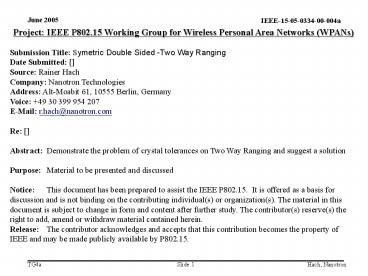Chirp Spread Spectrum (CSS) PHY Submission - PowerPoint PPT Presentation
Title:
Chirp Spread Spectrum (CSS) PHY Submission
Description:
Figure 1 Two-Way Time Transfer Model. Offset between A and B is reflected here! What about drift? ... SDS-TWR needs a minimum of only 3 messages ... – PowerPoint PPT presentation
Number of Views:32
Avg rating:3.0/5.0
Title: Chirp Spread Spectrum (CSS) PHY Submission
1
Project IEEE P802.15 Working Group for Wireless
Personal Area Networks (WPANs) Submission Title
Symetric Double Sided -Two Way Ranging Date
Submitted Source Rainer Hach Company
Nanotron Technologies Address Alt-Moabit 61,
10555 Berlin, Germany Voice 49 30 399 954
207 E-Mail r.hach_at_nanotron.com Re
Abstract Demonstrate the problem of crystal
tolerances on Two Way Ranging and suggest a
solution Purpose Material to be presented and
discussed Notice This document has been
prepared to assist the IEEE P802.15. It is
offered as a basis for discussion and is not
binding on the contributing individual(s) or
organization(s). The material in this document is
subject to change in form and content after
further study. The contributor(s) reserve(s) the
right to add, amend or withdraw material
contained herein. Release The contributor
acknowledges and accepts that this contribution
becomes the property of IEEE and may be made
publicly available by P802.15.
2
Whats the problem ?
- TWR as defined in the ranging subcommittee final
report (0581r07) is vulnerable to timebase
mismatch and thus crystal tolerances. - We propose that the UWB PHY should support
Symmetric Double Sided-Two Way Ranging (SDS-TWR).
3
Straightforward TWR Model according to
04-0581r07
Offset between A and B is reflected here! What
about drift?
Figure 1 Two-Way Time Transfer Model
4
Lets analyze the calculation of the propagation
delay
round trip time measured with clock A
reply time measured with clock B
Usually the reply time will be significant larger
than the propagation delay. Thus round trip time
and reply time will be almost equal! Example
tp30ns, treply1ms -gt tround1.000060 ms
5
What happens if there is a drift (difference in
clock speed) between clock A and clock B?
- Assume 10 ppm for clock A and -10 ppm for clock
B
big number measured with clock B
big number measured with clock A
wrong number!
10 ppm
-10 ppm
tp0.5(1.000060e-3(110e-6)-1e-3(1-10e-6))
40e-9 Problem Difference between large numbers
(e.g. 1ms) with different accuracies (10ns, -10
ns) has high inaccuracy!
6
Effect of high inaccuracy after subtracting two
large numbers measured with different clocks can
be avoided by using Symmetric Double Sided-Two
Way Ranging (SDS -TWR)
Device B
Device A
unknown propagation delay
reply time
7
Lets analyze the calculation of the propagation
delay for SDS -TWR
two big numbers measured with the same timebase
(clock B)
two big numbers measured with the same timebase
(clock A)
- Using the same example numbers as before yields
- tp0.25(1.000060e-3(110e-6)-1e-3(110e-6)1.0
00060e-3(1-10e-6)-1e-3(1-10e-6)) - -gt tp 30e-9
correct number!
8
How many message are required for SDS-TWR? At
least 3!
Device B
Device A
Device B
Device A
these two messages can be combined into one
9
Summary
- Straightforward TWR requires very low crystal
tolerances ltlt 10 ppm or precise phase tracking - SDS-TWR is an enhancement on Straightforward
TWR which eliminates the need of phase tracking - SDS-TWR needs a minimum of only 3 messages
- SDS-TWR can work with standard tolerances (up to
40 ppm or more)































